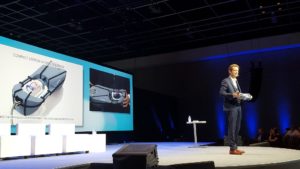 The business of care is adapting with the times, as life sciences proves a fertile ground for adopting new technologies to help in patient treatments. At this week’s busy 3DEXPERIENCE Forum, hosted by Dassault Systèmes, a technical-minded community gathered in Hollywood, Florida to exchange big ideas in the future of business. Opening the plenary session on Wednesday morning was Thomas Marchand, Co-Founding CEO and Chairman of Paris- and Boston-based BIOMODEX, speaking in a presentation entitled “3D Printing in Life Sciences – The Future is Already Here.” While the title sounds optimistic, Marchand is no futurist projecting Tricorders in your local hospital; rather, I learned as I sat down with him that afternoon, he is incredibly grounded in his views and sees 3D printing — and other digital ‘tools of the future’ — as a part to a whole, rather than a direct-and-only means to an end.
The business of care is adapting with the times, as life sciences proves a fertile ground for adopting new technologies to help in patient treatments. At this week’s busy 3DEXPERIENCE Forum, hosted by Dassault Systèmes, a technical-minded community gathered in Hollywood, Florida to exchange big ideas in the future of business. Opening the plenary session on Wednesday morning was Thomas Marchand, Co-Founding CEO and Chairman of Paris- and Boston-based BIOMODEX, speaking in a presentation entitled “3D Printing in Life Sciences – The Future is Already Here.” While the title sounds optimistic, Marchand is no futurist projecting Tricorders in your local hospital; rather, I learned as I sat down with him that afternoon, he is incredibly grounded in his views and sees 3D printing — and other digital ‘tools of the future’ — as a part to a whole, rather than a direct-and-only means to an end.
“What is the value of the 3D printing technology in the healthcare industry? It allows the manufacture of very complex parts, that’s number one. What is more complex than the human body?” he asked during his presentation. “The second value of 3D printing is to manufacture bespoke things. It’s not more expensive to make 1,000 different parts than 1,000 same parts. You have the complexity on the one hand and the personalization on the other hand.”
The bespoke nature of the technology means, he underscored, that the physician “can think of each patient as a unique case.” 3D printing can, as we’ve seen, end the days of one-size-fits-all, off-the-shelf medical treatment plans. BIOMODEX is positioning itself at the convergence point of what it sees as the three components of life sciences — patient, physician, and technology — “in a safe and replicatable environment.” By developing life-like 3D printed replicas of patient anatomy, created from their own medical imaging, the company is able to assist healthcare providers with a unique planning approach to procedures.
 BIOMODEX is a B2B company, working with the physician to provide safe, customized care plans for patients. The key word with which they approach the physician, Marchand noted, is “self-confidence”: the company wants treatment providers to be confident in offering the best solutions to those under their care.
BIOMODEX is a B2B company, working with the physician to provide safe, customized care plans for patients. The key word with which they approach the physician, Marchand noted, is “self-confidence”: the company wants treatment providers to be confident in offering the best solutions to those under their care.
The challenge facing BIOMODEX in developing its technological approach to the business of patient care was, he said, to reproduce the complex organic heterogeneous tissues that behave the same as those inside the human body; “that was a huge challenge, and is why we have developed a unique technology, INVIVOTECH. It is a unique technology protected by an IP portfolio as a barrier.”
“The core of the tech is an algorithm that builds 3D printed composite models to mimic the in vivo biomechanics of organic tissues,” Marchand explained. “We have access to some materials of 3D printing, and an algorithm computes a distribution of material to match the mechanical target of the patient — and we can do this for every single patient.”
Differentiating BIOMODEX from other anatomical model makers, which may create 3D printed organs with the correct shape and color, this company adds the functionality of the human organ. With the speedy turnaround characteristic of 3D printing and digital technologies, BIOMODEX is seeking to reach a one-day creation period for each patient-specific model, going from medical image to the HIPAA-compliant BIOMODEX server to INVIVOTECH technology to the physician. Marchand credits much of the company’s success with its team, made up of experienced biomechanicians and with the involvement of key opinion leaders — and further success to the support from Dassault Systèmes.
“We are very fortunate to have been sourced as the very first talent in the 3DEXPERIENCE Lab, in 2015. This is an acceleration program to help startups reach their technology goal and go to market as well. It is a five-year program offering a platform approach, software education and coaching, software integration, R&D opportunities. I am very glad that Monica has just agreed to be my mentor,” he said, referring to Monica Menghini, EVP and Chief Strategy Officer, Dassault Systèmes.
“We use CATIA, perform structure analysis with SIMULIA suite and project management with ENOVIA, even if we are a small 25-person startup. The value for us with the 3DEXPERIENCE platform as a startup is that we are a Generation Y company; we are comfortable with the cloud, where there is safety and traceability of data.”
Following the well-received presentation, I sat down with Marchand to learn more about the BIOMODEX approach to health, technology, and business.
“Every story starts by your users’ needs; here, it was a physician, a cardiologist who needed to plan a case,” Marchand told me of the company’s origins. “He knew it was possible to 3D print the images of a patient. Basically I was exploring what would be the best opportunities for using 3D printing in the life science industry. I was looking at this space of planning and how to 3D print unique organs. I was thinking about how can we help the physicians and the surgeons to assess the best treatment for the patient. He asked me to do a model for his patient in 2014. We did a sample on a very basic 3D printer. At the time, we succeed to 3D print an organ, and the physician has been able to watch the anatomy of his patient and think what would be the best treatment for the patient.”
Following this introduction to the use of technology to help a cardiologist, Marchand met Sidarth Radjou, with whom he would found BIOMODEX in 2015; “Sidarth is the engineer and I’m the business guy,” he explained of their focuses as co-founders. Two weeks after their first meeting, they became business associates, recognizing that their educational backgrounds were complementary as Marchand had completed his master’s thesis studying the use of 3D printing in healthcare while Radjou had worked in enhancing medical imaging in 3D printing. Radjou, Marchand noted, “is very focused on the biomechanics inside this space” and that focus is now “the key word inside BIOMODEX.”
Biomechanics for this team refers to “how the tissue reacts inside the body, and how to make this into a 3D printed model.” Translating the functions of the human body into a created, working model is eased through the use of multi-material 3D printing, which the first team members recognized as “the perfect solution to create some new materials to match the mechanical target we are looking for, that is a very complex mechanical behavior of the human tissues.” They then worked for two years to come up with their INVIVOTECH technology, having taken a look into the 3D printing hardware market leaders and seeking the best-suited multi-material 3D printers to work with in the creation of accurate, detailed medical models and using their algorithmic approach to develop high-quality files.
Compared to the homogeneous qualities of the silicone models physicians have been working with to date, Marchand said, the new multi-material models offer a heterogeneous quality; “it makes a huge difference, they say.” To be fully useful, “it has to match the human body.” While BIOMODEX spent significant time and energy in understanding the hardware they work with, they are fairly technology-agnostic here; they prefer multi-material MultiJet technology, but the difference for them comes to the quality of their developed model that allows for the precision in 3D printing. It’s this agnosticism that leads to another important point of differentiation for BIOMODEX in the 3D printing industry: this is not a 3D printing company.“It is an algorithm that builds this composite material and that will distribute the different materials at a micron level; we can control every single drop of the material to match the mechanical target we have,” he told me of INVIVOTECH. “We are inventing new composite materials thanks to this algorithm. This is protected by our IP strategy, it is very good for us to have this.”
“BIOMODEX is not a 3D printing company. We are a medtech company using 3D printing as a way to manufacture,” Marchand told me emphatically.
“Our client doesn’t care about 3D printing — and that’s good. We’re not working on the hype of 3D printing, we have a real clinical application the physician enjoys. Most of the physicians that do planning on our system don’t even think of the manufacturing way — is it 3D printing, is it casting — they don’t care. They just want an organ. They want an organ twin, and want to do their thing on it.”
He apologized, knowing that my journalistic focus is in 3D printing; I told him there was no need for that. I wholeheartedly agree that 3D printing should be a form of manufacturing technology used in the creation of viable, real-world products that can serve humanity. It’s not the hype that matters, it’s the result. As Marchand told me, “I don’t care how this chair is produced, I just want to sit in it,” I nodded; I’ve felt much the same about airplane components that ultimately help the plane to fly even if the passengers are none the wiser of how the big metal bird gets into the air. He wants to sit. I want to fly safely. Physicians want a useful medical model. Applications are helped greatly by the many advantages found in additive manufacturing, but at the end of the day the story is that these applications are viable.
For BIOMODEX, that application is in life sciences, bridging “the gap between and the value between watching the medical image on the screen and having this [model] on hand… Visualization of organs is not the best application you can have with 3D printing,” Marchand said. From a 3D printer, a medical model can get the appropriate shape and color, but it’s the functionality put in through a team experienced in biomechanics that creates that real value of what BIOMODEX has to offer.“If you don’t have the function, in vivo, biomechanical behavior, it doesn’t make any sense for the physician to touch the organ because it is not real. Most of our organs are soft in the human body, it is only bones that are hard,” he said. “This is why we have really focused our science, our go-to-market on adding the function to the shape of the organs. That is why we have a unique approach with key word biomechanics, and being able to reproduce this biomechanics for every single patient.”
The next steps for BIOMODEX are the monitoring of clinical feedback and the increase of automaton. Through tracking physicians’ feedback, the team will understand “how we can best help him to predict what will be the best treatment next time” following analysis of how a physician has helped a patient. For automation, BIOMODEX is “very focused on how to automate this process for the medical images to the 3D printing, including the biomechanics in the middle.”
Marchand credits the assistance and tools from Dassault Systèmes with the increase in automation, as well as aid through the 3DEXPERIENCE Lab accelerator in growing the business. With Menghini as his strategic mentor and access to the software, education, training, and R&D resources of Dassault Systèmes, BIOMODEX has grown notably in its young existence, as the overall platform available to them offers an invaluable growth resource.
“That’s a huge help for us, a huge competitive advantage to have one of the global leaders in R&D with already all the tools used in the industry and even in the medical device industry, which is using Dassault Systèmes tools. We are really looking forward to work with Dassault Systèmes not only as an accelerated startup but to be a real business partner at the end, because there are some go-to-market opportunities in common coming up,” he told me.
“The fact that we go from the digital file to a 3D printed model, really matches the strategy of Dassault Systèmes, the V + R you can see on the logo.”

Physician Pr. Jacques MORET from Paris employing the BIOMODEX system [Image: BIOMODEX / provided by Marchand]
“You really need to be fast to deliver in every single hospital and have a technology that is scalable for millions of patients at the end of the day,” he told me. “I mean, it is not just a proof of concept for your university, it becomes a business and we make money out of it as a real medical device company. The goal is not to say that we make money, the goal is to say that we went from something that was sexy three years ago, and print a heart when what’s the point of it, to have something that makes sense for physicians, something that lets them plan. If you add the clinical value, you have the commercial value at the end.”
BIOMODEX is seeing rising acceptance as the young company continues on its path forward. The company’s rising profile offers unique and viable solutions to healthcare providers, and with a thoughtful leader like Marchand at its helm, is sure to continue toward realistic, scalable expansion.
“We’re pretty proud of it, in the 3D printing organ space we’re one of the only companies that can make it real. It’s really exciting because the 3D printing industry is going from prototyping and funny proof of concept to a production paradigm. That is why it’s crucial for us to have a very strong knowledge of the 3D printers, to be able to scale, to make the 3D printers manufacture every day and every night,” he said.
How do you foresee the expansion of biomechanical 3D printed models? Let us know your thoughts at 3DPrintBoard.com, or share your comments below.
[All 3DEXPERIENCE Forum photos: Sarah Goehrke]
Subscribe to Our Email Newsletter
Stay up-to-date on all the latest news from the 3D printing industry and receive information and offers from third party vendors.
You May Also Like
Further Understanding of 3D Printing Design at ADDITIV Design World
ADDITIV is back once again! This time, the virtual platform for additive manufacturing will be holding the first-ever edition of ADDITIV Design World on May 23rd from 9:00 AM –...
3D Printer Maker EVO-tech Reborn as NEVO3D — Once More With Feeling
EVO-tech was a 3D printing service and original equipment manufacturer established in 2013 and based in Schörfling am Attersee, Austria. The company produced high-quality material extrusion systems featuring linear bearings,...
3D Systems Brings 3D Printed PEEK Cranial Implant to the U.S. with FDA Clearance
For more than 10 years, 3D Systems (NYSE:DDD) has worked hand-in-hand with surgeons to plan over 150,000 patient-specific cases, and develop more than two million instruments and implants from its...
CDFAM Returns to Berlin for Second Annual Symposium
The second CDFAM Computational Design Symposium is scheduled for May 7-8, 2024, in Berlin, and will convene leading experts in computational design across all scales. Building upon the first event...





































